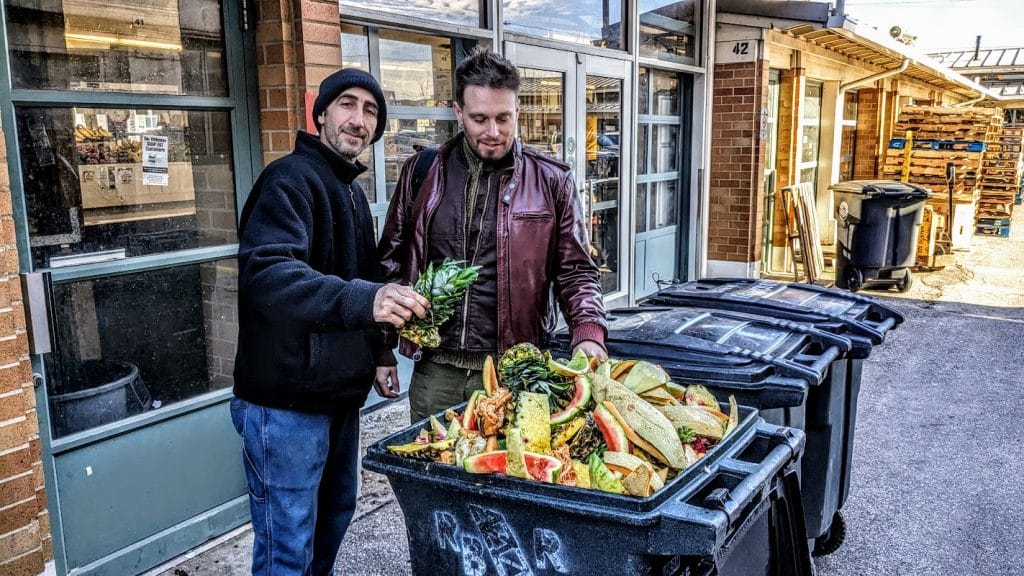
In the alley behind his stand at the West Side Market, Eddie Abu of Brothers Produce pointed to three 64-gallon containers teeming with melon rinds, pineapple stems, and other scraps. Three, it seemed, were not enough.
“I need four or five!” Abu told Robert Kurtz, who works with commercial clients of Rust Belt Riders, Cleveland’s leading compost company.
“I’ll get some over to you soon,” Kurtz replied. “Thank you for working so hard … You need any soil? You have a garden at home? I’ll bring you some soil.”
Abu wants to do his part for the environment by separating food scraps from compost instead of trashing them. “If I can help, why not?”
Another market vendor agrees. “You’re being way more productive by composting,” said Tom Boutros of Boutros Brothers Produce.
Last year, a $60,00 grant from the Robert Wood Johnson Foundation through Cleveland Neighborhood Progress helped Rust Belt start a pilot program to compost food waste from the market. This June, a $340,961 grant from the U.S. Department of Agriculture through Cleveland City Hall will help Rust Belt and partners boost composting around the city by expanding drop-off sites, making them free for people who can’t afford to pay, and getting more people to compost food waste.
Leaders want to put food waste on a diet. About 40 percent of America’s food goes unsold or uneaten each year. Most of it gets dumped in landfills with other trash. There it creates methane, which contributes to ozone, an air pollutant and greenhouse gas estimated to have caused 1 million premature deaths per year and about 30 percent of our accelerating climate change.
Wasting food wastes money: an estimated $428 billion per year. Food scraps make up about 30 percent of municipal garbage, costing Cleveland nearly $1.4 million per year in fees to dump, according to Orensel Brumfield of the city’s Department of Public Works.
Instead, composting makes soil, which helps to grow healthy food, reduces runoff, and sequesters or stores carbon dioxide, another big cause of climate change. “If we want a circular economy that preserves the value of our materials,” said Daniel Brown, Rust Belt’s leader, “the easiest and best place to start is with our food.”

“I just like the idea of creating less waste…”
Under the new grant, Rust Belt will work with Cleveland officials to expand its drop-off sites in the city from nine to about 19. Brown says that will help the city’s drive to turn neighborhoods into what are called 15-minute downtowns, with many conveniences within a short walk for most residents. People who qualify for public nutrition assistance programs (or food stamps) will be able to use all the sites for free.
The scraps will be turned into soil, many of them at Rid-All Green Partnership‘s 18-acre farm in Kinsman. Also at Rid-All, part-time ambassadors will be trained to explain and monitor drop-offs around town, and other workers will be trained for careers in composting.
Ohio Means Jobs will contribute $20,000 for training. The Cuyahoga County Solid Waste District will contribute nearly $35,000 in labor and materials for educating workers and residents. The city’s staff time will be covered by the grant.
Residential clients of Rust Belt like separating scraps. Megan Haftl said, “It’s one of the most sustainable things you can do.”
Tim Curran moved to West Park from a Seattle suburb that requires residents to separate food waste and then picks it up for free. Now he is a paying customer of Rust Belt. “I just like the idea of creating less waste and taking something that might not be useful and turning it into something useful,” he said.
Rust Belt charges residents $12 per month for unlimited drop-offs and $45 or more for weekly pickups. Client Audrey Yukon Quinn, who drops off her waste, said, “I see the monthly subscriptions more as a donation to something I believe in.”
Rust Belt can compost many items that home composters can’t. That includes meat, eggshells, paper bags, and some items certified by the Biodegradable Products Institute, such as bamboo tableware and compostable film canisters.
Clients say the chore is easy. They store waste in a compostable bag inside a sealed 5-gallon bin that emits no odor. If the bags fill up before they’re picked up or dropped off, many clients freeze them.
The 10-year-old Rust Belt Riders has 32 workers, 17 of them part-owners. It serves about 3,000 homes and 300 institutional sites in Greater Cleveland, including branches of the Cleveland Clinic, University Hospitals, and Phoenix Coffee.
The new grant will start in June and last two years. It amounts to about 3 percent of this year’s $11.5 million in federal funds to fight food waste around the country.
The West Side Market pilot will continue at least until the new, nonprofit Cleveland Public Market Corp. takes over the place. Rust Belt leaders hope to work out an extension, and so does Rosemary Mudry, the corporation’s leader. She said, “CPMC is very interested in pursuing programs like the pilot that make the West Side Market a more sustainable place.”
Learn more about Rust Belt Riders and composting options on their website.
